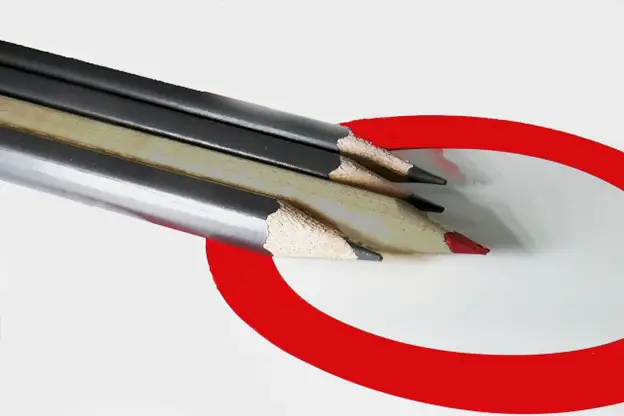Pencils are an artist’s best friend, and if you are working on an intricate piece of pottery, you need to have a guideline and some designs in place to get everything just right. However, the only problem is that the pencils we regularly use to draw might not be the ones you should pick for pottery work. So, what type of pencil to use for pottery? And why can’t you use regular HB pencils for creating designs on clay? Let us find out!
Why Can’t You Use Regular HB Pencils For Pottery?
Pencils that we use for regular artist work like sketching or writing are made up of graphite with varying hardness. The pencils with 6H tags are among the extremely hard ones, while those with 6B tags are extremely soft. Designs or guidelines that you make with these pencils on any ceramic surface will eventually burn out when it is fired in a kiln.
It might be a convenient option if you want the grids or guidelines to be erased before the pottery piece achieves permanency. However, if you want the design made with the pencil to stay, using a graphite pencil might not be the way to go about it.
So, what type of pencil should you use on your pottery work for the marks to stay? The answer is underglaze pencil. But what are they?
Underglaze Pencil For Pottery: What is It?
Underglaze pencils are designed to create marks on pottery pieces that don’t ever burn out when fired in a kiln. These pencils are created with clays, colorants, and refractory materials mixed in the right way. Unfortunately, unlike regular pencils, it is only available commercially in one hardness level that is somewhere close to the graphite pencil’s HB rating.
The HB hardness falls somewhere between 6B and 6H. Underglaze pencils, although perfect for pottery firing, don’t have a lot of color varieties. You can use these pencils on pottery pieces that are bisque-fired and sufficiently hardened so that they can withstand any pressure from the pencils while leaving a proper mark on the clay surface. However, keep in mind that the underglaze pencil can be a tad fragile when used on such hard surfaces. So, if your clay has a smooth surface with less grit, your drawing and sketching would be better.
How Can You Create Better Marks On Pottery With Underglaze Pencils?
If your underglaze pencil isn’t leaving a proper mark on the bisque-fired clay, the surface might not be smooth enough. So, how would you ensure that the pottery pieces have a smoother surface to help you create the designs better? The key is to sand the surface using silicon carbide (wet+dry) or paper made of aluminum oxide. Additionally, you can brush or spray the greenware surface with a coating of terra sigillata before bisque firing. This provides you with a harder surface to sketch your designs on.
Underglaze pencils can be used on pottery surfaces just the way you would with graphite pencils. However, you need to keep in mind that the sharper end tends to wear out quickly. So make sure you use a combination of side-pencil marks and tip marks and also create tones with the help of smudging/finger-rubbing that gives you a better potential to maximize the usage of your pencils. If you haven’t ever used underglaze pencils, a good place to start is with the Pasler Underglaze Pencil Set for greenware, bisque ware, and other pottery work. This pack of two black pencils is ideal for fine-line sketching, shading, and adding details.

Can You Make Underglaze Pencils At Home?
Yes, you can make underglaze pencils at home with the help of a slip that looks similar to porcelain. It is created with 50 percent plastic kaolin or white ball clay. To add strength to the greenware, you need to add bentonite (5 percent) or macaloid (3 percent). Additionally, other materials like colorants must be added to the mixture through a sieve in dry form. Make sure you ensure the materials blend thoroughly. Finally, to add color to the underglaze pencils, you need to select colorants that do not burn in high kiln temperatures. While most colorants don’t burn off in a kiln, potassium, selenium/cadmium, or dichromate will likely burn off. So, avoid using these in any case.
Conclusion
Whether you wish to use underglaze pencils for pattern transfer or reference for your actual design, they do work perfectly and don’t burn off. However, they can be a bit soft when working on gritty clay/ceramic surfaces. So, make sure the clay surface is sanded before you start adding your designs with an underglaze pencil.







